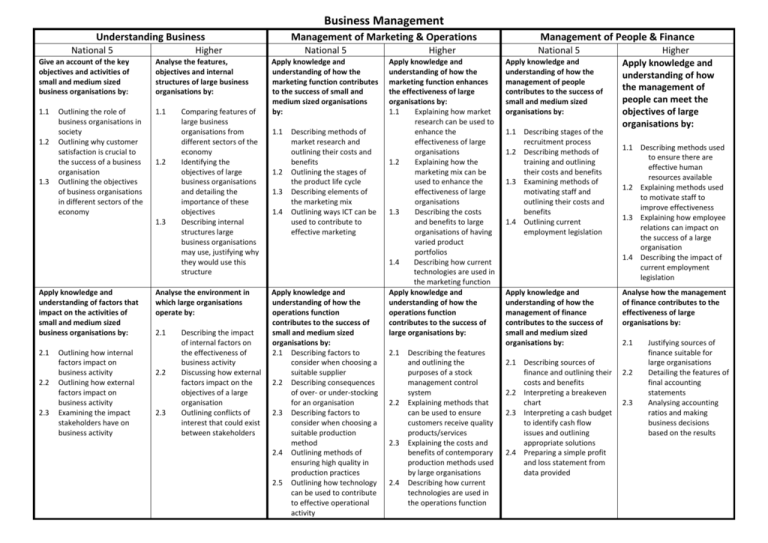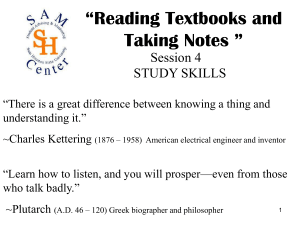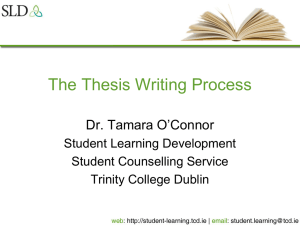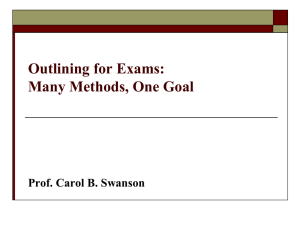Outcome 1
advertisement

Business Management Understanding Business National 5 Give an account of the key objectives and activities of small and medium sized business organisations by: Analyse the features, objectives and internal structures of large business organisations by: 1.1 1.1 1.2 1.3 Outlining the role of business organisations in society Outlining why customer satisfaction is crucial to the success of a business organisation Outlining the objectives of business organisations in different sectors of the economy 1.2 1.3 Apply knowledge and understanding of factors that impact on the activities of small and medium sized business organisations by: 2.1 2.2 2.3 Outlining how internal factors impact on business activity Outlining how external factors impact on business activity Examining the impact stakeholders have on business activity Management of Marketing & Operations Higher Comparing features of large business organisations from different sectors of the economy Identifying the objectives of large business organisations and detailing the importance of these objectives Describing internal structures large business organisations may use, justifying why they would use this structure Analyse the environment in which large organisations operate by: 2.1 2.2 2.3 Describing the impact of internal factors on the effectiveness of business activity Discussing how external factors impact on the objectives of a large organisation Outlining conflicts of interest that could exist between stakeholders National 5 Higher Apply knowledge and understanding of how the marketing function contributes to the success of small and medium sized organisations by: Apply knowledge and understanding of how the marketing function enhances the effectiveness of large organisations by: 1.1 Explaining how market research can be used to enhance the effectiveness of large organisations 1.2 Explaining how the marketing mix can be used to enhance the effectiveness of large organisations 1.3 Describing the costs and benefits to large organisations of having varied product portfolios 1.4 Describing how current technologies are used in the marketing function Apply knowledge and understanding of how the operations function contributes to the success of large organisations by: 1.1 1.2 1.3 1.4 Describing methods of market research and outlining their costs and benefits Outlining the stages of the product life cycle Describing elements of the marketing mix Outlining ways ICT can be used to contribute to effective marketing Apply knowledge and understanding of how the operations function contributes to the success of small and medium sized organisations by: 2.1 Describing factors to consider when choosing a suitable supplier 2.2 Describing consequences of over- or under-stocking for an organisation 2.3 Describing factors to consider when choosing a suitable production method 2.4 Outlining methods of ensuring high quality in production practices 2.5 Outlining how technology can be used to contribute to effective operational activity 2.1 2.2 2.3 2.4 Describing the features and outlining the purposes of a stock management control system Explaining methods that can be used to ensure customers receive quality products/services Explaining the costs and benefits of contemporary production methods used by large organisations Describing how current technologies are used in the operations function Management of People & Finance National 5 Apply knowledge and understanding of how the management of people contributes to the success of small and medium sized organisations by: 1.1 Describing stages of the recruitment process 1.2 Describing methods of training and outlining their costs and benefits 1.3 Examining methods of motivating staff and outlining their costs and benefits 1.4 Outlining current employment legislation Apply knowledge and understanding of how the management of finance contributes to the success of small and medium sized organisations by: 2.1 Describing sources of finance and outlining their costs and benefits 2.2 Interpreting a breakeven chart 2.3 Interpreting a cash budget to identify cash flow issues and outlining appropriate solutions 2.4 Preparing a simple profit and loss statement from data provided Higher Apply knowledge and understanding of how the management of people can meet the objectives of large organisations by: 1.1 Describing methods used to ensure there are effective human resources available 1.2 Explaining methods used to motivate staff to improve effectiveness 1.3 Explaining how employee relations can impact on the success of a large organisation 1.4 Describing the impact of current employment legislation Analyse how the management of finance contributes to the effectiveness of large organisations by: 2.1 2.2 2.3 Justifying sources of finance suitable for large organisations Detailing the features of final accounting statements Analysing accounting ratios and making business decisions based on the results Business Business in Action National 3 Influences on Business National 4 National 3 National 4 Outcome 1 Outcome 1 Outcome 1 Outcome 1 The learner will: The learner will: The learner will: The learner will: Research a small business and present the findings by: 1.1 Outlining the type of business ownership and giving a brief description of what the business does 1.2 Identifying the enterprising skills and personal attributes of the business owner(s) 1.3 Giving a brief description of how the business ensures it satisfies customers’ needs 1.4 Identifying sources of business financial support and/or advice 1.5 Outlining an advantage and a disadvantage of the type of business Outcome 2 Give an overview of how small businesses operate by: Give an overview of key stakeholders’ interests in small businesses by: 1.1 Identifying key stakeholders in small businesses 1.2 Outlining the key stakeholders’ interests in small businesses Outcome 2 Outcome 2 Outcome 2 The learner will: The learner will: The learner will: The learner will: Apply an understanding of functional activities supporting small businesses by: 2.1 Outlining the ways in which the functional activities support a small business 2.2 Selecting and using ICT to produce information used by each of the functional activities of marketing, human resources, operations and finance Give an overview of how small businesses satisfy customer needs by: 2.1 Stating the importance to a business of satisfying customer needs 2.2 Outlining how small businesses use market research information to satisfy the needs of customers 2.3 Describing promotional strategies used by small businesses 2.4 Describing quality measures used by small businesses Identify how internal factors influence small businesses by: 2.1 Stating suitable methods of recruitment or training for staff 2.2 Preparing a simple budget or cost statement Outcome 3 Outcome 3 Make decisions on the running of a small business, taking account of internal influences by: 2.1 Interpreting a simple cash budget or breakeven chart in order to reach a decision 2.2 Interpreting a simple job costing statement from data provided in order to reach a decision 2.3 Outlining the purpose of training employees 2.4 Describing methods of motivating staff Outcome 3 The learner will: Apply an understanding of key functional activities of small businesses by: 3.1 Describing the way in which each of the functional activities of marketing, operations, human resources and finance support a small business 3.2 Outlining how two functional activities work together in supporting small businesses The learner will: Identify how external factors influence small businesses by: 3.1 Identifying how a business might respond to the actions of a business competitor 3.2 Identifying how a business might respond to an economic or environmental influence 3.3 Identifying how a business might respond to a change in business legislation 1.1 1.2 1.3 1.4 Outlining reasons for individuals setting up in business Describing skills and attributes of entrepreneurs when developing a business Selecting a type of small business and outlining its features Describing sources of business finance and support when setting up a small business Give an overview of key stakeholders in a small business and their influence on it by: 1.1 1.2 Identifying internal and external stakeholders in a small business Describing the influences stakeholders can have on a small business The learner will: Give an overview of external influences that affect small businesses by: 3.1 Identifying the influences 3.2 Outlining the impact of the influences on small businesses 3.3 Describing a response to the influences by the small businesses






